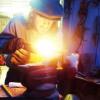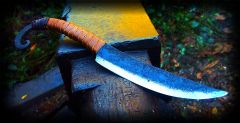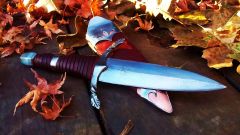-
Posts
84 -
Joined
-
Last visited
Content Type
Profiles
Forums
Articles
Gallery
Downloads
Events
Everything posted by Hilt and Hammer Workshop
-
I am no anvil expert,but it seems to be in decent condition to me. A bit of bowing on the face,but certainly minor .Edges have a bit of damage too,but again nothing severe. If you are a begginer ,it would be just fine to start out with. Way better ,in fact,than many beginers end up using. You have to realize that this is a very old anvil. I believe I can read "Patent" as part of the markings. i may be wrong ,but Wright anvils with "patent" stamped were made between 1852 and 1860. So considering the age,it's in decent shape. What is the seller asking for it? Price should reflect condition...
- 11 replies
-
- Peter Wright
- New Anvil
-
(and 1 more)
Tagged with:
-
Very ambitous attempt for your first blade. What furnace cement are you using? It seems like 72 hours would have been plenty of time to cure. I use Rutland furnace cement for hamons, and I've been able to throw the coated blade in the forge with no issues after only 15 hours of curing. Getting a hamon can be really tricky though. Make sure the blade is absolutely,completely clean before you apply the clay. I use grease cutting soap and warm water. Also,it's a good idea to pre-warm the blade by the forge so there's no initial "shock" when it goes in. Hope this helps make your next attempt more succesful :)
-
Wow. It weighs more than a lot of anvils do ! I've never seen anything nearly that large here in California. That's a fantastic find. I assume by the markings it was made in 1925?
-

Blacksmith Apron
Hilt and Hammer Workshop replied to HWHII's topic in Blacksmithing, General Discussion
Fantastic.I love the reddish tinge...although I'm sure it will be rather black all too soon. Why did you choose bison hide ? -
I would suggest copper for the spacer,to throw it out there. Iron and copper together look beautifully elemental. Very striking. Turning the wood is great,but I was refering to lining up the ends,where the pieces all join together. It's hard to get it all flush with zero gaps,say,between the spacer and the grip,or the grip and guard. Does that clarify my meaning?
-

I want my daily grind....
Hilt and Hammer Workshop replied to Hilt and Hammer Workshop's topic in Grinders, Sanders, etc
Thanks so much for the replies so far . At least it sounds like it will be useful for finer work,sharpening,maybe polishing and scale removal. At least it will speed up some labor,which is the very reason for the existence of machines. So if this is not good for heavy grinding, what HP/ belt width is common on more aggresive grinders?? Also,is there ever any problems with the belts slipping off the wheels? -
Good evening,friends. I've been crafting more blades than usaul lately,and have started looking into decent belt grinders. Then I remembered I might have one already ... As you can see,this isn't a Craftsman pile of junk hobby sander, but it isn't exactly a KMG either. It's manufactured by Dayton,certainly at least several decades ago.Very heavy duty and solid,belt width of 1 inch. It has a 1/3 HP split phase motor,which still runs smoothly. Now I for one have no experience operating or tinkering with one of these,so i turn to you most knowledgeable folks here. I have a few important concerns,notably, where can I find a belt for this exciting machine? And how does one measure the belt length? I couldn't find anywhere on the machine that told me what size i needed. Also , it seems there is a "rogue" idler wheel,that I can't figure out what purpose it has. I'm sure there are plenty of belt grinder experts here that can enlighten me. Does anyone else on here own one of these? I'd really love to get it up and running,but i don't want to lose any blood in the process. Any information on belt grinder maintanence,tips,as well as input on this particular one would be drastically apreciated.Many thanks I'd really love to get it up and running. Many thanks :)
-
Sounds like it will come together quite nicely. Leaving the pitting and discoloration will go well with the wrought iron hilt components. A word on forging wrought.... Since it's so varied in quality , I highly suggest working a small sample first. I've had problems with it cracking/splitting on the ends quite often,but it's probably my particular supply of wrought. Just make sure you get it nice and hot,and that should minimize problems. It's really amazing stuff. Also,I noticed you have a spacer in the middle of the grip. This is a real pain to work with if you aren't precise from the beggining,all though perhaps you already have experience with this. Lining up eight surfaces is finicky. Square everything up to start out with ( I like using a miter saw for the wood,and making sure the hilt pieces are even off the anvil). It's very rewarding when you're done though ! Make sure to show us photos of the finished piece. Cheers !
-

32-inch pointy thing completely successfull fail
Hilt and Hammer Workshop replied to FieryFurnace's topic in Swordsmithing
Applause to your efforts ! I too am very much a fan of small-swords ,although I like the earlier diamond cross section as opposed to the trianular blades. Very good looking though,from what I could see in your photos. Did you use any special hardy tools to get that crisp groove down the top? Your "heat treating forge" is marvelous in the way that it proves that it's not about the fancy tools,but care and skill . -
Congratulations. Nice job cleaning it up ! I'm still waitng for mine to come along...
-

My first blade (mildly pic heavy)
Hilt and Hammer Workshop replied to sharxbyte's topic in Knife Making
Funny you should mention the dangers of hot concrete! I tried making an "oven" style forge out of a concrete water meter box when I was even less knowledgeable. Lets just say that flying concrete shards do nothing to contribute to your bodily well being. Moving on.... If you're re-configuring your "backyard" forge set up, clay masonry bricks work very well. They hold the heat,are easy to find and most importantly do not explode :rolleyes: Railroad spikes are a good jump from rebar,for sure . They are quite popular to make knives out of,even though,again,they don't have enough carbon to facilitate a decent edge. Make no mistake,they will sharpen up alright, but the edge will dull quite swiftly with use. Railroad spikes have no more than 0.3% carbon, whereas for a blade,you want at least 0.5- 0.6% carbon content. http://www.bladeforums.com/forums/showthread.php/343476-Head-Markings-and-Carbon-Content-of-Railroad-Spikes It's neat to see you're local. Once I finish my workshop remodel, we should hammer some steel -

My first blade (mildly pic heavy)
Hilt and Hammer Workshop replied to sharxbyte's topic in Knife Making
It's a worthy start ! Now that you've gotten a good "feel" for how to shape steel,it would be my humble suggestion to move away from rebar. Quite honestly,it is horrible stuff,full of inclusions and hardly any carbon at all,which is neccesary for a knife blade to truly function as such. If you can pick up some junk springs to work with ,which have a decent carbon content, that can be your next step to making an ideal blade. I admire your perserverence to this point . Whereabouts in California are you? -

Vulcan anvil - Too far gone?
Hilt and Hammer Workshop replied to itsme's topic in Anvils, Swage Blocks, and Mandrels
I waited almost two years for the wright anvil to come along (see what I did there? ) . Patience is of the essence,my friend. There are anvils in all sorts of condition that people try to sell for prices that would make you think they were made of precious metals . If you find a good one (Trenton,Peter Wright,Hay Budden,etc.) in good condition,it will serve you well the rest of your career,and probably many more after that. My Wright is over 150 years old,and still going strong. Although I found mine on craigslist, it is ,like Eric said, a really good idea to form some connections with local smiths. The more people that know you are looking for one,the better. Best of success in the hunt ! -

Just how much for a post vice these days?
Hilt and Hammer Workshop replied to Hilt and Hammer Workshop's topic in Vises
Thank you for all the input,gentlemen. It sounds like I should just keep my eyes open for one. Ebay definately seems to be a poor place to get one, it's saturated with collectors and everything gets pushed top dollar. I suppose I can get by for a little while longer without one,as I am reconfiguring my shop,but it sure would be nice to have one once I'm finished with that. Cheers,everyone . -
Well I was so eager to delve into the fantastic wealth of information here over the last month or two that I've posted some discussions ,but forgot to introduce myself ! So hello . My name is Isaac, and I have an incurable disease...an illness of most horrific proportions. I have an insaitable apetitie to master the manipulation of metals. There's no turning back... no remedy...no escape. I will strike sparking steel until my hands no longer possess the strength to grasp my hammer and tongs . Okay so maybe that sounded a little too hardcore. Honestly, I am on a major learning curve. I have a general interest in the craft of blacksmithing ,but my specific and keen attention is focused on blades.Ever since I was in my early teens, I experimented with bladesmithing ,and I am still on that road. I've been influenced and inspired notably by David Delagardelle of Cedarlore Forge ,as well as other amazing craftsmen such as Owen Bush, Ben Potter ,and Jake Powning. One day ,I hope to be able to do as quality of work as they do. As of now, I'm working on building up both my tools and skills, and have created an experimental business/workshop very recently https://www.facebook.com/OfHiltAndHammer I look forward to contributing to this site and (virtually) meeting some of the incredibly talented craftsmen here
-
-
Greetings, fellow steel fanatics. I have a question about the monetary worth of post vices. If this topic has already been discussed,please refer me to the thread. Anyway, i've been getting by in the shop with an ordinary bench vice, but the more time I spend at the forge,the more I learn that is certainly less than satisfactory. So I'm on the hunt for a serviceable post vice. I'm in Northern California,and blacksmith tools in general are high cost and hard to find here, but should i really be expecting to pay $250- $350 for a decent vice? That seems to be the price range on craigslist ,and other places...even some on ebay are in that same spectrum. So are these things just going up in value,or are these prices I'm seeing way too high? I've heard some smiths say they only coughed up around $80 for theirs... Should I just keep looking?
-

Will this work for an anvil?
Hilt and Hammer Workshop replied to Voldemortism's topic in Anvils, Swage Blocks, and Mandrels
I definately concur with the conclusions that have been made so far. I *attempted* to use one of those plates for an anvil a long time ago, and it was pretty much worthless. Not only the lack of a center mass, but also the intense ringing sound when struck made it ,as VaughnT,far more trouble than it's worth. I actaully had to wear hearing protection, the ringing was so loud. On the other hand,if you can find a small section of railroad TRACK , that is a much better option for a makeshift anvil. All the best ,and happy pounding, whatever it may be on ;) -

Hammer Curiousity
Hilt and Hammer Workshop replied to Hilt and Hammer Workshop's topic in Hand Hammers
Excellent ! Thank you ,sir, that is precisely the answer I was hoping for . I appreciate the information. A blacksmith is a fool if he doesn't know his tools :) I really wish I knew how old it was, but I found absolutely no markings of any kind. Is there any other way of dating tools like this ? -
Greetings, and Merry Christmas, everyone. Recently,I finished restoring this seasoned old hammer as the rain silently cascaded over the workshop roof. The deep pitting originally covered the whole head, so I reground and polished the face and edges. The handle is a replacement ,of course, finished with fire and danish oil. This hammer is also a bit of a curiousity to me, not being a very experienced smith. It looks sort of like a straight peen hammer, but it's unuasaully long. Perhaps a chisel peen then? If anyone knows it's specific name and use, I'd love to hear it.
-
-



